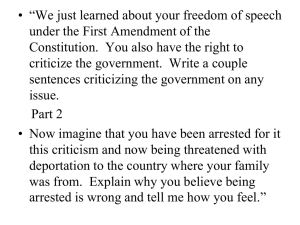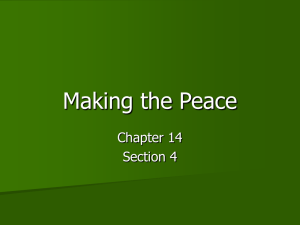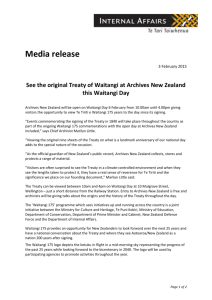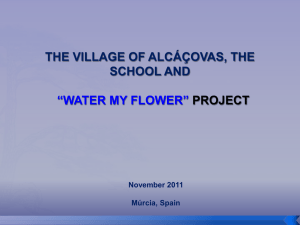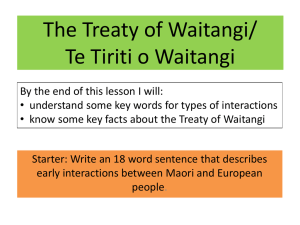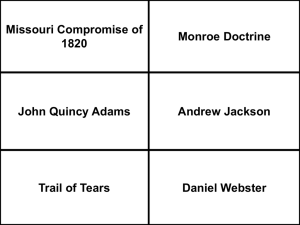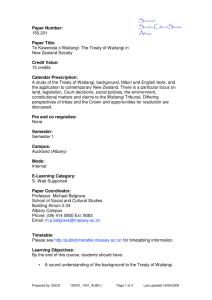Te Mana i Waitangi - Human Rights Commission
advertisement
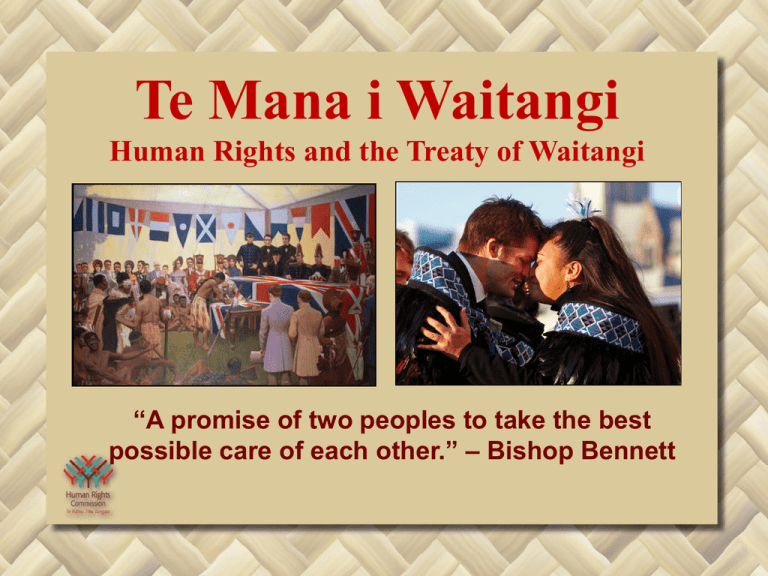
Te Mana i Waitangi Human Rights and the Treaty of Waitangi “A promise of two peoples to take the best possible care of each other.” – Bishop Bennett Tūrangawaewae “A standing place from where you gain the authority to belong.” (Hiwi and Pat Tauroa) The Treaty belongs to all of us. The Treaty of Waitangi 1840 The Treaty of Waitangi created tūrangawaewae for all New Zealanders. It also affirms the tūrangawaewae status that tangata whenua already possessed. The Treaty is the founding document of our nation. The Preamble tells us Who • Queen Victoria • William Hobson • Native Chiefs • Confederated and Independent Chiefs • Rangatira • Hapū • Her Majesty’s Subjects • Aborigines of New Zealand • Native population • Her subjects/people • Māori • Europeans • Australians Why • Recognition of Her Majesty’s Sovereign authority • Establish a settled form of Civil government • Preserve rangatiratanga and their land • Peace and quietness • Her tribe have settled in this country and (more) will come • Rapid extension of immigration • Protect just rights and property • Avert the evil consequences which must result from the absence of the necessary Law and Institutions How • Treat with the • • • • • Aborigines of NZ Concur Make a statement Negotiate with Accept and agree Constitute and appoint a functionary *All text is taken from the Treaty Article One – Kāwanatanga Purpose Governance/Kāwanatanga Who Crown/Government What Rangatira gave and the Crown gained an authority to govern Rights – for example: To make laws Gather taxes Set up institutions Make agreements with other peoples Represent the State Create property rights Responsibilities – for example: Ensure laws are fair Observe principles of natural justice Protect our constitution Provide services Ensure democracy Act in good faith Promote and protect human rights Respect the Treaty Article Two: Rangatiratanga Purpose Self Determination, Rangatiratanga Who Rangatira What - 1 The Crown promised to protect and Rangatira affirmed their authority over their taonga What - 2 Rangatira gave and the Crown gained the pre-emptive right to purchase properties Rangatira wished to sell Rights – for example: To protect and develop their laws (tikanga, kawa) Approve the use of their resources (rauemi) Protect and develop their institutions (whānau, hapū, marae) Make agreements with other peoples (whanaungatanga) Self determination (rangatiratanga) Maintain their distinct identity (whakapapa) Protect and develop beliefs (wairuatanga) Own property (hoko whenua) Responsibilities – for example: Respect the rights of others (manaakitanga) Exercise fair judgement (kawa) Sustainable protection of land, people and values (kaitiakitanga) Act in good faith (whakapono) Promote and protect human rights (mana tangata) Protect their world views (mātauranga) Respect the Treaty Purpose Article Three: Rite Tahi Rite Tahi, Equality, Tūrangawaewae Who Citizens and Residents What The Crown gave Tangata Whenua the same rights as British subjects, who gained the authority to belong Rights – for example: Equality before the law Fair process Free speech, thought and beliefs Good health and education Culture Vote To belong (turangawaewae) Own land or property Responsibilities – for example: Obey the law Participate in community Pay taxes Vote Promote and protect human rights Protect and assist youth Look after people who are vulnerable Respect the Treaty Wairuatanga This statement was read to the meeting before any of the Rangatira signed The Treaty: “The Governor says that the several faiths (beliefs) of England, of the Wesleyans, of Rome and also Māori custom shall alike be protected by him.” International Standards Declarations and Treaties help to: • Establish standards • Affirm the rights and responsibilities of the parties Examples: • Universal Declaration of Human Rights (UDHR) • Declaration on the Rights of Indigenous Peoples (UNDRIP) • International Covenant on Civil and Political Rights (ICCPR) • International Covenant on Economic, Social & Cultural Rights (ICESCR) Current Issues • • • • • • Sovereignty vs Kāwanatanga Rangatiratanga vs possession Indigenous Rights Settlement of grievances Relevance today: Constitution Forums for engagement What other Treaty issues are current? Te Mana i Waitangi The Treaty of Waitangi established a set of rights and obligations and a relationship between the Crown and Rangatira which remains in place today. It created a governance framework for the nation (kāwanatanga), affirmed the existing rights of Tangata Whenua (rangatiratanga) and guaranteed shared citizenship and equal rights for all (rite tahi). The Treaty has been described as: “The promise of two peoples to take the best possible care of each other.” The human rights dimensions of the Treaty of Waitangi include both universal human rights and indigenous rights. Human Rights Commission, Statement of Intent 2009-2010


